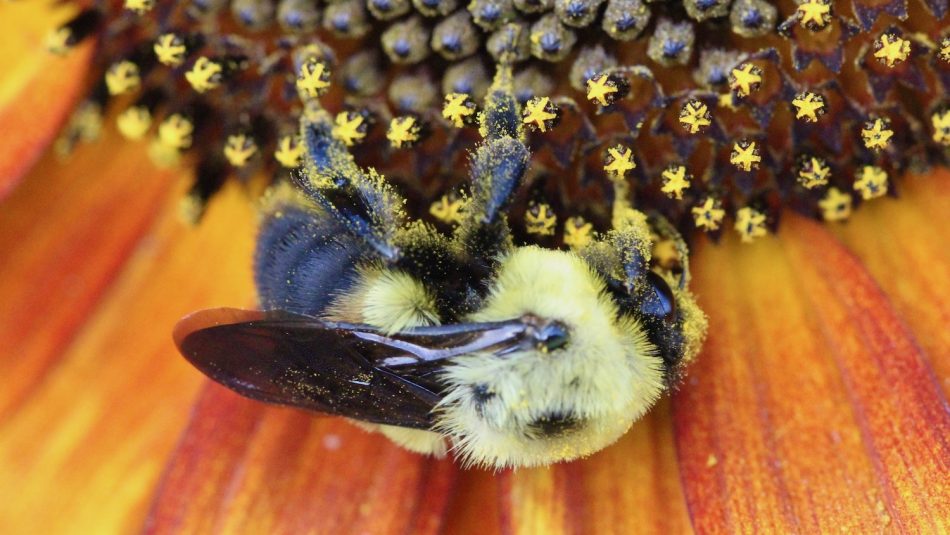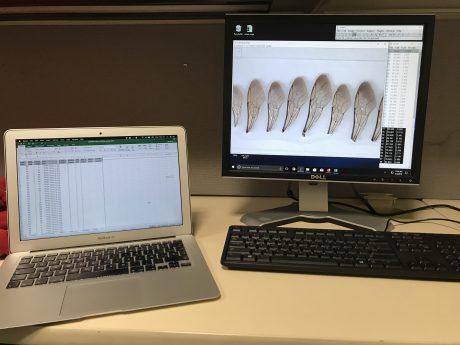2019-20 Global Change Fellow Publishes Findings on Parasite Transmission in Bee Colonies

2019-2020 Global Change Fellow, Mario Simon Pinilla-Gallego is lead author on a new publication, Within-Colony Transmission of Microsporidian and Trypanosomatid Parasites in Honey Bee and Bumble Bee Colonies that was recently published in the journal, Environmental Entomology. The paper was co-authored by Emma E Williams (Cornell University), Abby Davis (Cornell University), Jacquelyn L Fitzgerald (NCSU), Scott H McArt (Cornell University), and SE CASC Faculty Affiliate, Rebecca Irwin (NCSU). This post was written by Chief Science Communicator for the Department of Applied Ecology, Michelle Jewell for the Applied Ecology news site here.
Bees Can Limit Low-Level Parasite Spread Within Colonies

When parasite pressure is low, bees can control how quickly the parasites spread within colonies, and this might be due to social immunity.
All bees risk encountering parasites any time they stop at a flower. An unrelated study in New York found that as many as 1 in 10 flowers had parasites on them and flowers can be visited a few to dozens of times per day. Some flowers are more likely to harbor parasites because of their shape and the way bees move across the flower to forage. Ultimately, it is a matter of time before a bee encounters parasites and brings them back to their colony, but little was known about how parasite infections spread within colonies.
A collaborative study at NC State’s Department of Applied Ecology used two agriculturally significant bee species for this study, western honey bees and common eastern bumble bees. Both species are important pollinators for native ecosystems and agricultural industries and both species have relatively large colonies, hypothetically the perfect breeding grounds for parasites.
“Having healthy populations of both managed and wild bees is essential to maintain good yield of many crops,” says Simon Pinilla-Gallego, lead researcher and Ph.D. student. “Understanding how parasites spread and what factors control their transmission dynamics are the first steps toward developing strategies to control them.”

For this study, colonies of both honey and bumble bees were brought to a laboratory and infected with either high or low levels of two common gut parasites, a Trypanosomatid Crithidia bombi that infects bumble bees and a microsporidian Nosema ceranae that infects honey bees. Researchers then measured the transmission rates, the severity of parasite loads in individuals, and the performance of the colonies over five to seven weeks.
In the high infection rate trials, bumble bee colonies experienced a higher spread rate of infection whereas honey bees didn’t see as large of a spread as the bumble bee colonies, but the honey bees that were infected were severely infected. In the low infection rate trials, both bumble bees and honey bees were able to slow the spread of the parasites. This suggests that both bees are able to effectively use a secret weapon to keep low-grade infections in check, perhaps social immunity.
“When the parasite pressure is low, we suspect that the social immunity of both bee species can control the spread of the parasites in the colony, but there is a limit to that mechanism,” says Pinilla-Gallego. “If the parasite pressure is too high, then the parasites will spread in the colony pretty fast, which also contributes to having more bees spreading the parasites in the environment.”
The more we understand about parasite transmission within bee colonies, the better farmers and ecologists can prepare for the implications of potential infections in hives. It also shows that taking steps to actively reduce the levels and amounts of parasites in the environment would be greatly beneficial to all pollinators.
Watch how Simon and his team conducted these experiments in Simon’s video below:
The paper, “Within-colony Transmission of Microsporidian and Trypanosomatid Parasites in Honey Bee and Bumble Bee Colonies” was published in Environmental Entomology on September 22, 2020. The paper was authored by Mario ‘Simon’ Pinillia-Gallego, Jacquelyn Fizgerald, and Rebecca Irwin from NC State’s Department of Applied Ecology, and Emma Williams, Abby Davis and Scott McArt from Cornell University. The research was funded by the National Institute of General Medical Sciences of the National Institutes of Health (R01GM122062).
- Categories:
